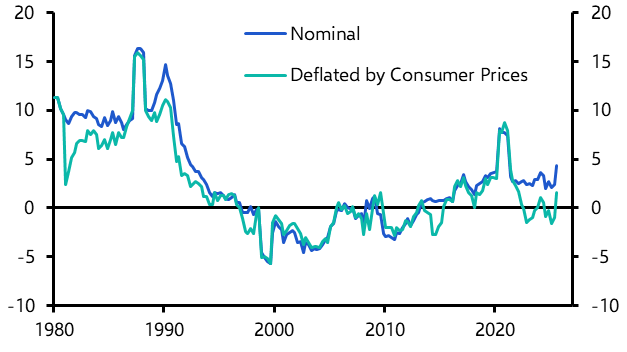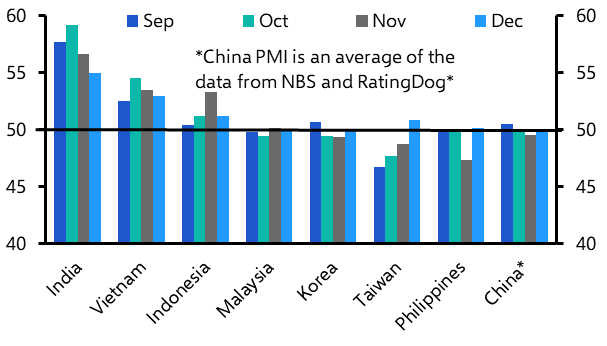Regular readers will know that we’ve been among the most bearish forecasters for global growth over the past 6-12 months. Consistent with this, at the start of this year we argued that government bond yields would fall and that yield curves would flatten. But the rally in government bond markets has surpassed even our expectations. The US yield curve is now partially inverted and – unsurprisingly – recession indicators that run off of the yield curve (such as that produced by the New York Fed) are now pointing to a the highest probability of a US recession since the global financial crisis. Meanwhile, German government bond yields are now negative across the curve.
At first sight, the gloom in the bond market is easy to justify. German industry is in recession, Asian exports are contracting and the US ISM manufacturing index is close to a three-year low. We don’t agree with the widespread view that the escalating trade war between the US and China poses a major threat to growth in both countries, but it clearly doesn’t help. And on top of all of this we are now faced with the increasing likelihood of a “no deal” Brexit.
Yet in thin summer trading it’s important to retain some perspective. For every piece of negative data (and there has been plenty) it’s possible to find a positive release. German industrial production fell in June, but industrial orders for the same month were strong. Chinese exporters are struggling, but our China Activity Proxy suggests that strength elsewhere, most notably in property construction, has helped to shore up growth. Growth in Japan was surprisingly strong in Q2. And at a global level, while investment and jobs growth have weakened, capex and hiring intentions have stabilised.
Accordingly, while there are pockets of extreme weakness in the world economy – particularly in manufacturing – other parts are holding up relatively well. All of this is consistent with our view that global growth is slowing rather than collapsing.
Where might we be wrong? Three downside risks are worth watching over the coming months. The first is that the indirect effects of the trade war turn out to be larger than we anticipate. In the short-term at least, most of the economic damage from the tariffs is likely to stem from the indirect effects on things like business confidence and investment rather than the direct effects on trade flows. These indirect effects are difficult to measure and can extend beyond the countries imposing tariffs on one another. But a sharp drop in business investment over the coming months would be a sign that the costs of the trade war may be larger than we had anticipated.
The second downside risk is that financial conditions tighten. As it happens, the market turbulence of the past couple of weeks has not led to a significant tightening of financial conditions in major economies. (See Chart 1.)
Chart 1: Capital Economics Advanced Economy Financial Conditions Indicator (Standard Deviations)

But that’s largely because investors have responded to the gathering gloom by pricing in ever larger amounts of monetary stimulus. This raises the risk that the scale of central bank loosening falls short of market expectations, causing financial conditions to tighten and exacerbating the downturn to in the real economy. (In this respect, it’s possible that the feedback loop from monetary policy to financial conditions makes further central bank easing a self-fulfilling prophecy.)
Finally, it’s worth keeping an eye on developments in the service sector. While the manufacturing sector is in recession, the service sector has remained relatively resilient. The gap between the manufacturing and services PMI is now at a five-year high and it’s unusual for a divergence between the surveys to persist for long. (See Chart 2.)
Chart 2: Advanced Economy Manufacturing & Services PMI

In 2004-05, the gap was closed by a rebound in manufacturing. But in 2012-13, it was closed by a drop in the services index. The extent to which the services sector can remain insulated from the current troubles in manufacturing will be a key factor shaping the outlook for the next six months.
In case you missed it:
(Requires login)
- Our Senior Europe Economist, Jack Allen-Reynolds, explains why the euro-zone could become the next front in a global trade war.
- Our Chief Emerging Markets Economist, William Jackson, asks whether a household debt bubble is starting to inflate in Russia.
- Our Senior China Economist, Julian Evans-Pritchard, looks at China’s next steps in the trade war.




